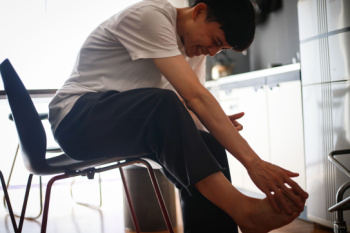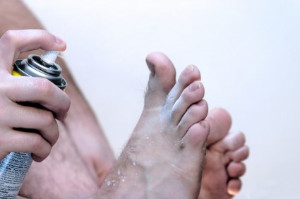Items filtered by date: April 2024
Definition and Risk Factors of Cracked Heels

Cracked heels, medically known as heel fissures, refer to the splitting or fissuring of the skin around the heels. This common foot condition can be painful and unsightly, affecting both the appearance and functionality of the feet. Cracked heels often occur when the skin becomes dry, thickened, and lacking in moisture, leading to the formation of deep cracks or splits. Several risk factors contribute to the development of cracked heels, including prolonged standing or walking, wearing open-back shoes or sandals, and obesity. Additionally, diabetes, aging, and certain medical conditions such as eczema or psoriasis may lead to developing cracked heels. Environmental factors like cold weather and low humidity levels can exacerbate dry skin, making it more prone to cracking. Neglecting proper foot care, such as inadequate moisturizing, can worsen the condition. By understanding the definition and risk factors associated with cracked heels, individuals can take proactive steps to prevent and treat this uncomfortable foot ailment. If you have cracked heels, it is suggested that you visit a chiropodist sooner rather than later who can provide effective relief methods, which may include prescribed medication.
Dry, cracked heels are more than a cosmetic inconvenience. For many people, they are uncomfortable, deep, painful, and may even bleed. If you suffer from cracked heels, please consult with Chiropodist Stephanie Poupore from North Bay Foot & Ankle. Our clinician can help you maintain the health of your lower limbs and your mobility.
Causes
Prolonged standing
Wearing open-back shoes
Wearing shoes that don’t cushion the heels
Living in a cold or dry climate
Taking long, hot showers
Not moisturizing the heels
Eczema
Psoriasis
Palmoplantar keratoderma
Juvenile plantar dermatosis
Treatments
Soaking the feet
Exfoliating with a pumice stone
Moisturizing the heels
Wearing closed-back shoes that cushion heels
Avoiding prolonged standing
Taking warm, rather than hot, showers
Treating underlying skin conditions
While milder cases of cracked heels can be treated at home, some patients present with deep, painful, bleeding heel fissures that are at risk of becoming infected and may require medical care. Additionally, patients with diabetes or any other conditions that affect the immune system should be monitored by a chiropodist.
If you have any questions, please feel free to contact our office located in . We offer the newest diagnostic and treatment technologies for all your foot care needs.
Tips for Diabetic Foot Care

Proper foot care is crucial for individuals managing diabetes. Maintaining good hygiene by washing and drying feet daily helps prevent infections. Regular foot exams are essential for checking for cuts, blisters, or other abnormalities. Monitoring blood glucose levels consistently aids in effective diabetes management and reduces the risk of foot-related issues. Diabetic neuropathy and poor circulation can lead to foot problems such as ulcers or infections, necessitating immediate attention. Chiropodists specialize in foot care and can offer valuable assistance. They provide guidance on proper footwear, offer preventive measures, and promptly treat any foot ailments. Chiropodists conduct comprehensive foot exams, identifying potential problems early on. If you have diabetes, it is strongly suggested that you schedule regular appointments with a chiropodist for specialized care to mitigate risks and ensure optimal foot health.
Diabetes can cause serious problems in the lower limbs if proper preventive measures are not taken and diabetic wound care is not performed. If you would like to learn more about caring for diabetic feet, please consult with Chiropodist Stephanie Poupore from North Bay Foot & Ankle. Our clinician can help you maintain the health of your lower limbs and your mobility.
Diabetes can lead to a host of foot and ankle complications, including:
Poor circulation
Peripheral neuropathy
Diabetic foot wounds and ulcers
Infection
Corns and calluses
Dry, cracked skin
Nail disorders
Hammertoes
Bunions
Charcot foot
If you have diabetes, you must be vigilant of any changes in your foot health. This is best done through daily foot inspections. Using a mirror to help you if necessary, look for any:
Cuts, scrapes, sores, or wounds
Bruising or discoloration
Swelling
Rash
Foul odor
Nail changes
Hair loss
Warmth and inflammation
Deformities
Lower limb pain
Strange sensations (numbness, tingling, burning, pins, and needles)
If you detect anything unusual, seek the care of a chiropodist as soon as possible. If you have any questions, please feel free to contact our office located in . We offer the newest diagnostic and treatment technologies for all your foot care needs.
What Does Gout Feel Like in the Feet?

Gout in the feet can be excruciating, often characterized by sudden, intense pain, swelling, redness, and warmth in the affected joint, commonly the big toe. It is a type of arthritis caused by the buildup of uric acid crystals in the joints, leading to inflammation and severe discomfort. Gout typically occurs when the body produces excessive uric acid or has difficulty eliminating it, resulting in high levels in the blood. Factors such as diet, genetics, obesity, and certain medications can contribute to gout flare-ups. Treatment options for gout include medications to reduce inflammation and uric acid levels, lifestyle modifications such as dietary changes, and weight and pain management strategies. A chiropodist can assist by providing education on gout management, evaluating foot health, recommending appropriate footwear, and offering interventions to alleviate pain and improve joint function, contributing to better overall foot health and quality of life. If you have had one or more gout attacks, it is suggested that you are under the care of a chiropodist who can help you with management techniques.
Gout is a painful form of arthritis that can affect anyone. Please consult with Chiropodist Stephanie Poupore from North Bay Foot & Ankle. Our clinician will assess your condition and provide you with quality foot and ankle treatment.
What Is Gout?
Gout is characterized by sudden, severe attacks of pain, redness, and tenderness in the joints. This type of arthritis is caused by a buildup of uric acid in the bloodstream. When uric acid crystallizes in a joint, often the joint of the big toe, it can bring about a gout attack.
Symptoms
Symptoms of gout include:
Sudden and severe pain
Swelling
Redness
Warmth
Joint stiffness
Joint deformity
Diagnosis
A chiropodist will ask questions about your personal and family medical history, followed by an examination of the affected joint. Laboratory tests and x-rays are sometimes ordered to determine if the inflammation is caused by something other than gout. A sample of fluid taken from your joint can show whether it contains uric acid.
Treatment
Prescription medications or injections are used to treat the pain, swelling, and inflammation. Patients with chronic gout can also use behavioral modifications such as diet, exercise, and decreased intake of alcohol to help minimize the frequency of gout attacks. Foods and beverages that are high in purines should be avoided since purines are converted in the body to uric acid. If left untreated, this painful condition can leave your joint permanently damaged and swollen.
If you have any questions, please feel free to contact our office located in . We offer the newest diagnostic and treatment technologies for all your foot care needs.
Get Professional Care for a Broken Foot or Ankle
Prevention Tips for Athlete’s Foot

Athlete's foot, medically known as tinea pedis, is a common fungal infection affecting the skin of the feet. This condition thrives in warm, moist environments, making sweaty socks and tight shoes ideal breeding grounds for the fungus. Symptoms include itching, burning, and cracked, peeling skin, often between the toes or on the soles of the feet. To prevent athlete's foot, it is essential to keep feet clean and dry, especially after swimming or sweating. Wearing breathable footwear and changing socks regularly can help minimize moisture buildup. Additionally, avoiding walking barefoot in public places like locker rooms or communal showers reduces the risk of exposure to the fungus. Proper foot hygiene, such as washing feet daily with soap and water and thoroughly drying them afterward, is vital. When using communal facilities, wear protective footwear like flip-flops to provide an extra layer of defense. If you have developed athlete’s foot, it is suggested that you visit a chiropodist who can offer you effective treatment remedies, which may include prescribed medication.
Athlete’s foot can be uncomfortable and unsightly. To learn more about preventing and treating this condition, please consult with Chiropodist Stephanie Poupore from North Bay Foot & Ankle. Our clinician will assess your condition and provide you with quality foot and ankle treatment.
What Is Athlete’s Foot?
Athlete’s foot refers to an infection of the skin on the feet that is caused by a fungus. This fungus is contagious and thrives in warm and moist environments. It is often spread in common areas such as public pools, locker rooms, and showers. It can also spread when sharing personal items, like shoes or towels, with an infected person.
Symptoms
The symptoms of athlete’s foot may include:
Itching, stinging, or burning of the skin on the feet
Cracking or peeling skin, especially between the toes and on the soles of the feet
Scaly, red rash on the foot
Blisters
Foul odor
Treatment
Treatment for athlete’s foot typically involves using over-the-counter topical antifungal medications on the feet. When over-the-counter options are ineffective, you may need to take prescription oral medications or topical antifungal drugs, or a combination of both.
Prevention
Preventing athlete’s foot places an emphasis on good foot hygiene practices.
You can prevent athlete’s foot by:
Washing and drying your feet thoroughly every day
Wearing shoes when walking in public areas
Not sharing personal items, like shoes or socks, with others
Wearing shoes and socks made out of breathable materials
If you have any questions, please feel free to contact our office located in . We offer the newest diagnostic and treatment technologies for all your foot care needs.
A Guide to Measuring Shoe Size at Home

Measuring shoe size accurately at home can ensure a comfortable and proper fit for footwear, especially when unable to visit a store. Begin by gathering a ruler or measuring tape, a piece of paper, and a pencil. Place the paper flat on the ground and position your foot on it, ensuring your heel is against a wall. Use the pencil to mark the longest part of your foot, usually the tip of your longest toe. Measure the distance from the heel to the toe mark in centimeters or inches. Repeat the process for the other foot, as they may differ slightly in size. Once both measurements are obtained, refer to a shoe size chart, typically available online, to determine your correct shoe size. It is advisable to measure your feet in the afternoon or evening when they are at their largest due to natural swelling. By following these simple steps, you can confidently find the right shoe size from the comfort of your home, ensuring both comfort and style in your footwear choices. If you are seeking additional information about the importance of finding your right shoe size and how to accomplish this, it is suggested that you confer with a chiropodist.
Finding the right shoes can be a hassle, however, wearing properly fitted shoes is one of the best things that you can do to prevent future foot problems. For more information about the importance of wearing the right shoe size, please consult with Chiropodist Stephanie Poupore from North Bay Foot & Ankle. Our clinician can help you maintain the health of your lower limbs and your mobility.
Tips for finding shoes that fit
Measure your foot - This should be done later in the day when your feet are naturally at their largest. An associate at a shoe store can measure your foot using a Brannock device.
Wear the right socks - You should be wearing the socks or other hosiery that you intend to wear with the kind of shoe you are looking for. For example, if you are shopping for running shoes, wear the socks that you would normally wear while running.
Remember these numbers - When trying on shoes, there should be about ½ an inch of space between the end of your longest toe and the end of the front of the shoe, and ⅛ of an inch between the back of your heel and the shoe
Don’t “break them in” - Any shoes you buy should be immediately comfortable; don’t settle for shoes that you have to “break in" before you can wear them out.
A chiropodist can help you find the best shoes and orthotics to help maintain the health of your feet. If you have any questions, please feel free to contact our office located in . We offer the newest diagnostic and treatment technologies for all your foot care needs.

